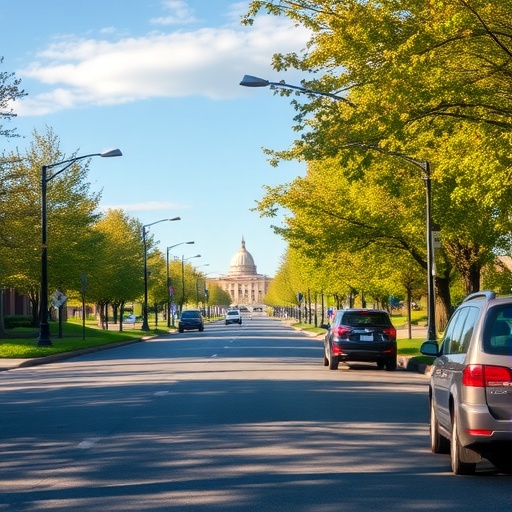In recent years, the impact of transportation on urban environments has become a focal point for sustainability efforts. As cities grow and the challenges posed by climate change become ever more pressing, innovative strategies are being explored to mitigate these issues. One such approach is the implementation of No-Drive Day initiatives within Higher Education Institutions (HEIs). This initiative seeks to reduce vehicular traffic, thereby enhancing air quality and decreasing noise pollution, crucial factors in fostering a healthier urban habitat and promoting climate action.
The No-Drive Day concept is simple yet powerful. By designating specific days on which driving is discouraged or prohibited, cities aim to significantly lower the number of vehicles on the road. This, in turn, has the potential to improve air quality by reducing emissions from cars, which are major contributors to urban air pollution. The rationale behind this initiative stems from the understanding that improvements in air quality have direct correlations with public health, particularly in densely populated areas where exposure to pollutants is high.
Evidence suggests that when communities reduce their reliance on personal vehicles, they not only enjoy immediate benefits in terms of cleaner air but also experience longer-term improvements in public health outcomes. Respiratory diseases, cardiovascular issues, and even mental health problems have all been linked to poor air quality. Thus, the role of No-Drive Days becomes particularly crucial in fostering an environment where both the population and the surrounding ecosystem can thrive.
In addition to improved air quality, another critical aspect of the No-Drive Day initiative is the reduction of noise pollution. Urban environments are often characterized by persistent noise generated from vehicular traffic, which can lead to a variety of health concerns and hinder the quality of life. Studies have shown that excessive noise can contribute to stress, sleep disturbances, and decreased cognitive functionality among urban residents. By reducing traffic on specific days, communities can experience a notable decrease in sound pollution, leading to a more serene urban atmosphere.
Moreover, the No-Drive Day initiative aligns seamlessly with broader climate action goals. Each aspect of sustainability in urban planning—from waste management to transportation—contributes collectively towards mitigating the effects of climate change. By encouraging residents to shift towards alternative modes of transport such as cycling, walking, or public transit on No-Drive Days, these initiatives promote a cultural shift towards sustainability. This behavioral change is necessary for long-lasting environmental benefits, as it encourages individuals to rethink their daily commuting habits and consider the environmental impact of their choices.
The adoption of No-Drive Days isn’t without its challenges. In many regions, car culture is deeply ingrained, with individuals often viewing vehicle ownership as synonymous with personal freedom and convenience. Addressing this cultural mindset requires comprehensive communication strategies that highlight the benefits of reduced driving, such as the cost savings associated with less fuel consumption and lower vehicle maintenance expenses. Furthermore, educational campaigns can inform residents about the direct health benefits of cleaner air and quieter streets, fostering community buy-in for the initiative.
Higher Education Institutions, being hubs of innovation and thought leadership, are in a unique position to champion No-Drive Day initiatives. By implementing these measures on campus, universities can serve as laboratories for sustainable practices while engaging students, faculty, and staff in meaningful dialogue about climate action and sustainability. Such initiatives not only contribute to the institution’s environmental goals but also enhance the campus experience, making it more conducive to learning and community interaction.
The effectiveness of No-Drive Days can be amplified through collaborative efforts between local governments and educational institutions. By working together, these entities can share resources, implement complementary programs, and create infrastructure that supports alternative modes of transportation. For instance, increasing the availability of bike lanes or enhancing public transit options can help decrease reliance on personal vehicles, ensuring that No-Drive Days are more achievable for a broader segment of the population.
Quantifying the success of No-Drive Day initiatives is essential for justifying their implementation and expanding their reach. Metrics such as air quality indices, traffic volume studies, and resident surveys can provide critical data to measure the impact of these initiatives. Analyzing this data not only showcases the benefits achieved but also helps refine the approach for future events, ensuring that these initiatives evolve in response to community needs and environmental challenges.
In conclusion, No-Drive Day initiatives present an innovative approach to urban sustainability, particularly within Higher Education Institutions. By tackling the dual issues of air quality and noise pollution, these initiatives contribute to a healthier environment and broader climate action efforts. As we continue to explore solutions to the pressing challenges posed by urbanization and climate change, the potential of No-Drive Days to effect change in both behavior and policy cannot be underestimated. With strategic implementation, community engagement, and effective partnerships, No-Drive Days could very well redefine urban living and pave the way for a more sustainable future.
Subject of Research: No-Drive Day initiatives towards sustainability in HEI through improved air quality and reduced noise pollution supporting climate action.
Article Title: No-Drive day initiatives towards sustainability in HEI through improved air quality and reduced noise pollution supporting climate action.
Article References:
Relton, C., Mary, A.D.C., Banu, D.U. et al. No-Drive day initiatives towards sustainability in HEI through improved air quality and reduced noise pollution supporting climate action.
Discov Sustain 6, 998 (2025). https://doi.org/10.1007/s43621-025-01857-8
Image Credits: AI Generated
DOI: 10.1007/s43621-025-01857-8
Keywords: No-Drive Day, Sustainability, Higher Education Institutions, Air Quality, Noise Pollution, Climate Action.




